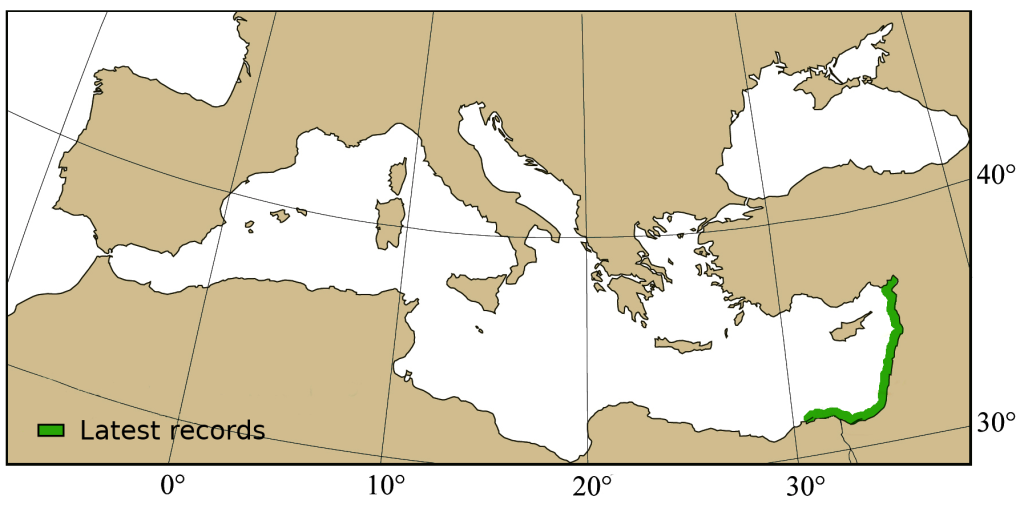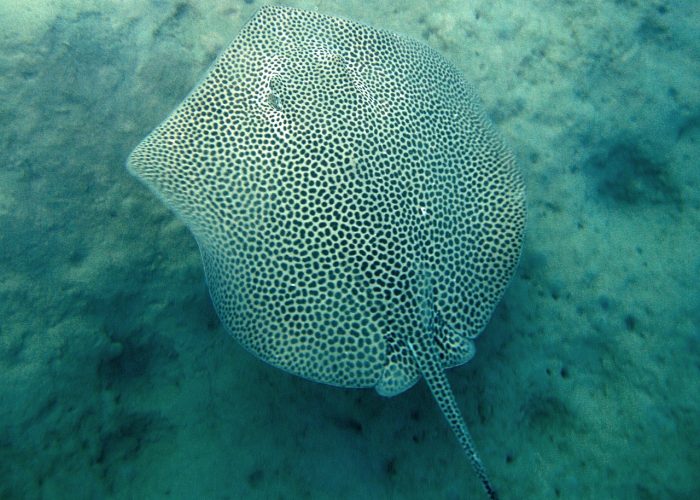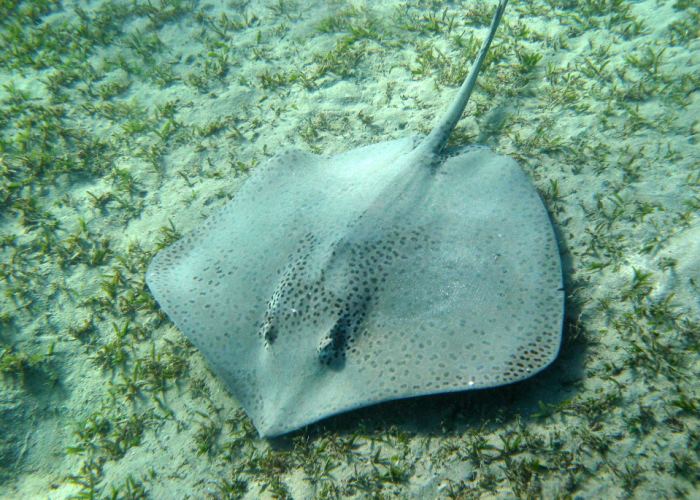Himantura cf. uarnak
Common name: Honeycomb stingray, Coach Whipray.
Order: Myliobatiformes.
Family: Dasyatidae.
Synonyms: Himantura punctata, Dasyatis uarnak, Himantura tutul.
Remarks: H. uarnak belongs to a species complex where we include here H. leoparda recently recorded in the Mediterranean.
Short description
Huge stingray with an obtuse and angular snout. Relatively romboidal disc with nearly straight anterior margins. Pectoral fin apex rounded (in juveniles) to nearly rounded in adults. Spiracles situated closely posterior to eyes. Head distinctly protrudes from the body. Mouth floor with 4-5 fleshy papillae. Dorsal surface mostly smooth with a series of medium small flattened tubercules from eyes to tail base in adults. Indented dorsal spine. Long whip-like tail and nearly 2.5-3.5 times body length when intact, with one (rarely two) serrated spines close to its base. No skin folds on the tail tip.
Color: Dorsal surface with any dark brown rings/spots and blotches on light brown to gray-yellow backgrounds. Spot well-spaced in young but crowded to form reticulated patterns in adults. Tail with points and marks like rings. Cream-white ventral surface.
Measurements:
- Disk width (DW): 130-200 cm (max 450 cm)
- Total length (TL): 300-450 cm
- Weight: to 150 kg.
Swimming pattern: Undulatory locomotion.
Biology / Ecology
Feeds on small fishes, bivalves, crabs, shrimps, worms and jellyfishes.
Reproduction: Viviparous (aplacental viviparity). Size at maturity (DW): 82-100 cm after 4 years. Gestation period: 1 year. Juveniles per litter: 2-6. Size at birth (DW): 20-28 cm.
Habitat: Demersal and benthic species; inhabits sandy or muddy bottoms from surface to 50 m of depth. Common on sandy beaches and in shallow estuaries and lagoons.
Unclear distribution since older records were all identified as H. uarnak.
Distinguishing characteristics
- Dorsal surface with many dark brown rings/spots and blotches on light brown to gray-yellow backgrounds.
- One serrated spine close to the base of the tail.
- 4-5 fleshy papillae.
Myliobatiformes: No caudal and anal fin. Thin tail like a whip.
Dasyatidae: Batoids with depressed bodies.
Distribution
Worldwide: Widely distributed in the tropical Indo-Pacific region.
Mediterranean: Recent Lessepsian immigrant, from the Red Sea through the Suez Canal. Found along the Levantine basin.
- Occurrence: Rare.
- Latest records: Lebanon (2018), Iskenderun bay – Turkey (2016), Syria (2015), Egypt (1994).

Any recent observation not on the map?
Contact us!
Conservation
Threats: Bycatch in artisanal and industrial fisheries. Retained for human consumption for its meat, cartilage and thorny tail.
Protection level:
- Global: Endangered (IUCN 2021, last assessment: 2020)
Key references
- Adib S., Basha N.A., Tufahha A. Barakat I., Capapé C. 2021. First substantiated record of leopard whipray, Himantura leoparda (Myliobatoidei: Dasyatidae) from the Syrian coast (Eastern Mediterranean Sea). FishTaxa 19: 5-8.
- Ali M., Saad A., Reynaud C., Capapé, C. 2013. Additional records of honeycomb stingray Himantura uarnak (Chondrichthyes: Dasyatidae) off the Syrian coast (Eastern Mediterranean). Tishreen University Journal for Research and Scientific Studies-Biological Sciences Series 35(4): 216-22.
- Arlyza I., Shen K.N., Solihin D.D., Soedharma D., Berrebi P., Borsa P. 2013. Species boundaries in the Himantura uarnak species complex (Myliobatiformes: Dasyatidae). Molecular Phylogenetics and Evolution 66: 429-435.
- Bariche M., Al-Mabruk S.A., Ates M.A., Bûyük A., Crocetta F., Dritsas M., Edde D., Fortic A., Gavriil E., Gerovasileiou V., Gökoglu M., Huseyinoglu F.M., Karachle P.K., Kleitou P., Terbiyik Kurt T., Langeneck J., Lardicci C., Lipej L., Pavloudi C., Pinna M., Rizgalla J., Rüstü Özen M., Sedano F., Taskin E., Yildiz G., Zangaro F. 2020. New Alien Mediterranean Biodiversity Records (March 2020). Mediterranean Marine Science, 21(1), 129-145.
- Basusta N., Erdem U., Kumlu M. 1998. TTWO NEW FISH RECORDS FOR THE TURKISH SEAS: ROUND STINGRAY TAENIURA GRABATA AND SKATE STINGRAY HIMANTURA UARNAK (DASYATIDAE). Israel Journal of Zoology, 44:1, 65-66.
- Golani D., Dulcic J., Azzurro E., Massutí E., Orsi-Relini L. 2019. Atlas of Exotic Fishes in the Mediterranean Sea – 2nd edition In: Briand F., CIESM Publishers / Paris, Monaco, 365 pp.
- Manjaji-Matsumoto B.M., Last P.R. 2008. Himantura leoparda sp. nov., a new whipray (Myliobatoidei: Dasyatidae) from the Indo–Pacific. Descriptions of new Australian Chondrichthyans, CSIRO Mar. Atm. Res. Pap, 22, 293-301.
- Yucel N., Sakalli A., Karahan A. 2017. First record of the honeycomb stingray Himantura leoparda (Manjaji‐Matsumoto & Last, 2008)(Myliobatoidei: Dasyatidae) in the Mediterranean Sea, confirmed by DNA barcoding. Journal of Applied Ichthyology 33(3): 530-532.



